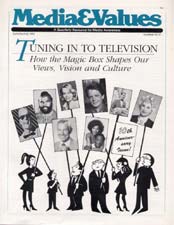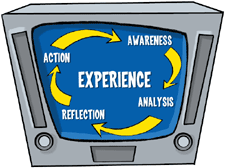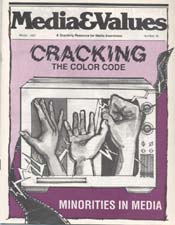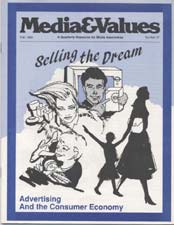Working with Basics: Miracles DO Happen!
|
Article Images:
Citation: Posted on Media-L Listserve on May, 23, 1996. |
A few weeks ago I wrote to this list asking for ideas and suggestions about a 3-week "media" unit that I was asked to do with a group of "basic-level" high school seniors in their last three weeks of school.
There were a large number of kind responses which willingly shared ideas, approaches and thoughts -- and for those I'm most grateful. You folks asked me to let you know how it went, and this is it.
Let me re-cap briefly. I'm the "A/V" guy at a suburban high school in Billerica, Massachusetts. A teacher who had been hearing a lot about "media literacy" came to me a few weeks ago and said, "Look -- my senior basics group is tired of reading. They're tired of writing, and frankly, so am I. Can you come in and do a little "media literacy" unit for their last three weeks of high school?"
At my high school, there are three levels of English classes -- Honors, College Prep, and "Basic" (We don't call it "basic" when anybody's listening, but that's what it is). Those of you who are teachers probably understand that the class can be a "dumping ground" for non-college kids, screw-ups, discipline problems, lazy kids, unmotivated kids and anyone else who slips through the cracks. I'm not defending it, mind you -- just telling you. No one really calls these kids "dumb" anymore (but they USED to). They're NOT, but that's how they're too-often treated. And although we KNOW that everyone is a "Life-Long Learner," many people suspect that this is that last formal education these kids are going to get. Again -- not defending it -- just telling ya.
Anyway, it's strange to walk into a class in mid-May as a "visiting teacher." I mean, the "class chemistry" is already set. And (thankfully for me), what a wonderful "chemistry" it was. The real problem kids had flunked out or dropped out by this time in May, and what was left was about a dozen kids and a teacher who really cared about them as people. They were mutually supportive and respectful. In fact, some of them actually went out LOOKING for their classmates to drag them to class on time because another "cut" would mean that they wouldn't graduate. The teacher was supportive . . . interested . . . (in them and in learning about media). It was great.
An aside: I'm just telling you what we wound up doing. There really wasn't a "plan" (sorry about that!). We were flying by the seat of our pants . . . trying to see what worked . . . what they connected with . . . and then went from there. We were making it up as we went along. No, this ISN'T a model or a curriculum or anything like that -- and I don't present it as such. I'm just telling you what went on. You can take what you want from it.
And frankly, I'm wonderfully excited as I sit here telling you about it. I mean, it's one thing to KNOW and BELIEVE something, like the fact that media empowers kids. But it's quite another thing to SEE it happening right in front of you. Whew. (Yes, I'm still on a high).
Anyway, as they were wondering who this guy was standing in front of them ("I think he works in the school library."), I tried to get them talking about TV. You know how that goes. They started giving the answers they thought I wanted. So I showed them that Howard Beale speech from the film "Network." You know . . . "Television is a goddammed amusement park. We're in the boredom killing business . . . You're never going to get any truth from us . . . You people are what's real . . . WE'RE the illusion." We started talking about the uses of TV . . . . . . THAT got them going . . . We also talked about the uses and abuses of amusement parks in general . . .
The talk turned to commercials . . . so I started bringing in commercials -- the standard ones, but also tapes of Clio Award shows and stuff like that. As we talked about what commercials they liked and didn't like, we also drifted into stuff like "Who was the commercial made for? What's the target audience? WHY did they do that? Did it work? Do you like it? Hate it? Why? How are they trying to get you to watch? What are they saying? What's the FEELING of the commercial? What are the predominant images? Why?"
Anyone reading this list knows all this stuff, so I'm not telling you anything new. The kids picked-up on some of the basic appeals right away. We listed them on the board.
What was so special was that the teacher (the teacher THEY'D been learning from for 8 months) was sitting right with them participating with them. We really did learn from each other. When we saw a commercial that used sex, she thought that it was terrible and complained about it. She was truly shocked. Another commercial was SO soft and sweet and "motherly" it literally brought tears to her eyes. And she told us about it, and we rewound and watched the commercial again and again . . . looking for those elements which so effectively had "pushed her buttons." It was a process of discovery . . . first we would just watch a piece and react to it . . . then we'd go back and see what it was that had caused us to react as we had.
When someone disagreed, they said so. The kids listened to each other, built off each other's ideas, and we all literally learned from each other as we shared. We noted differences in our reactions.
There was one kid up back who wouldn't talk at all. The teacher told me later that he just wasn't the talkative kind -- he never said a word. He was there (I mean REALLY "there"), and I could see in his face that he was listening and understanding, but he said not a word. When we asked him what he thought, he mumbled something and waved us away -- "Naw. Nuthin'" Finally, as we were deconstructing about the tenth commercial, he opened up.
"Hey!" he said, "It's TV! It's a COMMERCIAL! It's SUPPOSED to be fake! Everybody knows that! What the hell are you expecting? Some great literature or somethin'? It's only TV!"
Those of you who are teachers know the feeling when someone like that not only opens up, but opens up with insight and a strong point of view. The teacher's mouth dropped. Later she said that it was the very first time he had offered a reaction to ANYTHING. Anyway, we talked about construction . . . about "faking" things . . . about what commercials were supposed to do . . . He began to tell us what he thought and later confessed to another teacher that what we were doing in class was "pretty cool."
We went on to print ads. This "advertising" thing was just going too well to switch topics, so we switched genres. And we talked about the same kinds of things . . . target audiences . . . appeals . . . what gets your attention . . . whether there's information or image or just suggestion in ads . . .
The Head of the English Department came in to observe one day, and he asked his OWN questions. Had these kids ever done an activity like this before? They told him no. They'd NEVER "done" advertising or commercials or anything like that? Nope. No teacher had ever brought it up. The teacher and I decided that it was going so well that we'd have the kids design their own advertising messages. There was about a week left . . .
Now these are kids whom NO ONE has EVER trusted with a camera, much less a precious video camcorder or access to editing equipment. And many of their classes were built along regimentation rather than freedom, on parroting back stuff you learned rather than coming up with new ideas. I'm not defending this, mind you -- just telling you.
They went nuts. The teacher was in shock. "They're actually DOING it!" she said.
I'm not telling you guys anything new when I tell you that the kids had this intuitive kind of knowledge about what they were doing . . . But I'm still amazed.
The teacher made it even more fun by announcing that anyone who designed a spot which hit HER (personal) buttons would surely get an A. So they knew their audience . . .
Two "jocks" talked about doing a TV commercial for Nike. And I watched as the idea grew and grew and got changed and blossomed. No -- not Nike, but those "flip-flops" that folks wear in the summer. But ADVERTISE them as if they WERE Nikes. Appeal to women. Teenagers. Mrs. Petullo herself. OK. There are these two guys, playing basketball, right? And there are these 2 girls just sitting on the sidelines watching them, right? The girls ask if they can play. The guys let them. And the girls really stink. The guys tell them to go away . . . The girls, saddened, trudge off to the sidelines, where they change from their sneakers into flip-flops. And then they come back onto the court and they're GREAT! They're making three-point shots . . . they're dunkin' the basketball like Michael Jordan! They actually knock the guys over, they're so good! And then we see the slogan: "Don't just do it. FINISH IT!" And the last shot is the guys lying on the floor with the girls standing ON TOP of them!
And as I heard their ideas, I asked them to "just sketch out" the scenes in order. When they'd finished it, I told them that they'd just done a storyboard.
I'd help them with the camerawork if they'd do everything else. And so they reserved a gym . . . made arrangements to get a basketball . . . got 2 girls who agreed to "act" with them in the spot . . . They were being producers, but they didn't know it until we told them. Organizing stuff. Making arrangements. One went up to K-Mart to buy the flip-flops. The other one got a stepladder from the custodians so that we could stand one of the girls on the stepladder and have her "dunk" the ball from there.
We got it all shot in just one period. They were directing . . . telling me what they wanted each shot to look like. They used their storyboard as a script. When someone laughed or screwed-up, we re-shot a scene.
Then we started to edit.
The teacher is still in shock. "These kids have NEVER worked this hard on ANYTHING before!" she said. "And what's more . . . they're LOVING it!" One of the guys "found" two or three free periods a day to come down to the editing room and work on editing the commercial. ("Hey! It's the last week and I'm a senior. I can afford to miss that class.")
Then they wanted a part of it in slow-motion -- the part where the girl jumps up (and we cut to her seemingly in mid-air, stuffing the basketball into the net). Can we do slow-motion?
"No. We've only got the very basics here, guys . . . just consumer equipment and a simple editing bay."
But they wouldn't give up. What if we tried THIS?
They tried it. Nope.
What if we tried THIS?
Doesn't work.
Well, what about THIS?
It works! Slow-motion! (A little grainy, but it works!)
Suffice it to say that I learned something here, too -- something I thought was impossible that THEY wouldn't give up on.
Back to editing . . .
A day before the project is due . . . it still needs something. Hey! What about if -- as the girls are putting on their flip-flops, we have this real dramatic music? I suggested the Lone Ranger theme. They didn't know what I was talking about and suggested the theme from "Rocky." One of them had the music at home . . .
Well, it was perfect . . .
I made up these videotape labels with the kids' names on it and put them on the tape. They were amazed. They'd never seen their name in print before -- certainly not actually printed on the label of a videotape!
We had worked for a week on this 90 second spot. They were proud it, and insisted on going last when the ads were shown today -- the last day of class.
Well, of course, the reaction from the class was great. They laughed when the tape suddenly switched to slow-motion and they saw this girl seem to fly through the air and dunk the basketball. When the "Rocky" theme on, everyone roared . . .
And we talked about it. What techniques did they use? What's the commercial "really" saying? That girls can do just as well as guys (better, actually) if they have these flip-flops? (The teacher LOVED that message!)
But frankly, folks . . . it's one thing to TALK about empowerment and quite another thing to see it in action. Those two guys comandeered the VCR in the library and showed their commercial to anyone who wanted to see it for the rest of the day. At times there were 30 kids gathered around the TV . . . puching each other on the shoulder, hooting and shouting, laughing.
They've already made 4 copies of the tape (one for each of them, one for the teacher, one for me). OF COURSE each tape has to have its own specially-printed label and box.
I mean, these kids are so proud they could nearly burst. And justifiably so. When we talked about the steps they had to go through to make this . . .
And the teacher is still running around the school telling anyone who will listen what her "basic level" seniors did. One of the other students made a video spot for cat food -- she shot all these cutesy pictures of kittens and puppies playing and edited them together with a voice-over about how your pets are as active as you are . . . When she played the tape, there was a chorus of "Awwwwwww's" (as in "Awwwww. Aren't they CUTE?"). Perfect.
Other kids did print ads . . .
The quiet kid up back did a car ad. He said it was an ad designed for kids like him, so the ad featured a big (hand-drawn) red car with little inserts of its "features." And the features he chose to highlight were the shiny manifold and exhaust, the excellent stereo system, and the mag wheels. He said that he would have talked about other features if his ad was for adults, but it wasn't. It was for teenage guys like him.
Sheesh.
I mean . . . not only did they GET it . . . (and easily, too -- they KNOW this stuff) . . . and not only did they DO it . . . but they were justifiably proud of what they did. It WAS good work. Insightful. Done with care and thought and planning. It might have been the only time their work had been characterized like that, but it's true.
And their teacher is a convert. On the final exam she's going to xerox a print ad from a magazine and ask them to deconstruct it (right after the questions on "The Glass Menagerie.") It's going to be worth 25 points.
I apologize to you teachers out there. You KNOW all this stuff and no doubt see it daily. And I apologize to ALL of you who have slogged through this lengthy description of what we wound up doing. But I did want to thank you for your ideas, suggestions, and support. And to tell you that -- even as unplanned and haphazard as it was -- it worked out great.
And maybe to remind all of us (myself included) what a tremendously empowering tool media literacy can be.
Whew.
Reprinted with permission by the author.





 Black viewers watch more television but also read the highest percentage of publications. Teenage boys like programs that poke fun at male authority figures.
Black viewers watch more television but also read the highest percentage of publications. Teenage boys like programs that poke fun at male authority figures.

 helped make them inaccessible to many teens. But the arrival of the VCR has given them a new outlet. With their under-20 characters and sexually-oriented plots, these R-rated films are aiming for a young audience.
helped make them inaccessible to many teens. But the arrival of the VCR has given them a new outlet. With their under-20 characters and sexually-oriented plots, these R-rated films are aiming for a young audience.


 generate some kind of emotional response? Or both? What techniques are used by the copywriter: humor, alliteration, definitions" of life, comparisons, sexual innuendo, and so on?
generate some kind of emotional response? Or both? What techniques are used by the copywriter: humor, alliteration, definitions" of life, comparisons, sexual innuendo, and so on?